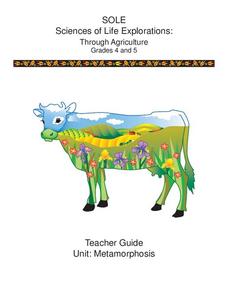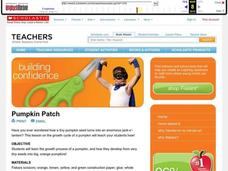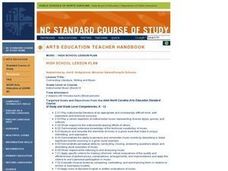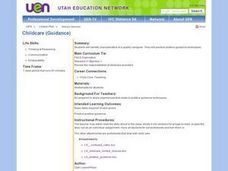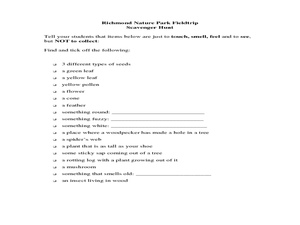Cornell University
Metamorphosis
Looking for an insect unit that addresses multiple skill strategies? Young entomologists explore multiple life cycles of insects that go through metamorphosis. The brainteasers and mobile activity spark learner interest before guiding...
Cornell University
Insect IPM
Find out the characteristics that makes a bug an insect with a workbook designed to inform scholars about the crawly creatures that live around us. Scholars complete an ant-themed word search, answer questions using a solution key,...
Wordpress
Introduction to Exponential Functions
This lesson begins with a review of linear functions and segues nicely over its fifteen examples and problems into a deep study of exponential functions. Linear and exponential growth are compared in an investment task. Data tables are...
Curated OER
Butterfly Round-Up
Students classify the characteristics of butterflies and moths moths. In this life cycle lesson, students identify butterflies and moths common in the state of Iowa as well as their characteristics. Students then learn the proper...
Curated OER
Pumpkin Patch
Students create a pumpkin art project that outlines the life cycle of a pumpkin in order to learn the growth process of this particular vegetable. In this pumpkin art instructional activity, students first review the life cycle of a...
Cornell University
Let’s Raise Lacewings
Young entomologists explored beneficial insects and how they help control pests in the first lesson of the series. Now class members take a close look at the lacewing, which is a beneficial insect.
Curated OER
Are You One of Us?
Learners compare and contrast insects and arthropods, identifying characteristics of each. In groups, they sort pictures of arthropods into the five different classes of arthropods. They also sort pictures into insect and non-insect piles.
National Security Agency
What’s Your Coordinate?
Your middle schoolers will show what they know with their bodies when they become the coordinate plane in this conceptual development unit. Starting with the characteristics of the coordinate plane, learners develop their skills by...
Allegany-Limestone Central School
Plantae WebQuest
Send your young life scientists on a plant webquest that has them reading case studies to decide if seeds are seeds and plants are plants.
Curated OER
Strawberry Girl: Outdoors in Florida
Students explore nature by researching the state of Florida. In this animal identification lesson, students read a children' story and research the Internet to discover the difference in animal life between the early 1900's and present...
Curated OER
Crickets Guided Discovery
Sixth graders investigate insect anatomy by analyzing a live cricket. In this insect science lesson, 6th graders discuss their knowledge of insects and describe their characteristics from memory. Students observe live...
Curated OER
Music of My Heart
High schoolers view and discuss the movie, Music of the Heart. They compare/contrast two versions of the song, Music of My Heart, identify characteristics of heroes, and sing the song, Music of My Heart.
Curated OER
Diversity of Life
Students identify the difference between eukaryote and prokaryotes and examine the structure of bacteria. In this bacteria lesson students examine the different ways that bacteria are classified through an activity.
Curated OER
The Rainforest
Students learn the characteristics of the rainforest. In this rainforest instructional activity, students read stories about the rainforest and discuss them. Students work in groups to brainstorm all the facts they know about...
Curated OER
Connecting Literature, Writing and Music
Students assess the impact of music to portray emotions and tell stories. Examples are taken from the life of Rosa Parks and a piece of band music called "A Movement for Rosa". Evaluation is accomplished through in-class participation...
Curated OER
Tree Lesson
Pupils compare and contrast characteristics of conifer and hardwood trees. After collecting samples of branches around the school, they classify the branch as hardwood or conifer. Groups of students identify given twigs. They go...
Curated OER
Childcare (Guidance)
Students identify characteristics of a quality caregiver. They practice positive guidance techniques.
Curated OER
Music - O Brother, Where Art Thou?
Students practice singing with correct posture. They sight read music and sing in choral harmony. Students identify the characteristics of a melody and examine the style of Southern Baptist hymns.
Curated OER
Sort Laboratory Practice
Eighth graders sort animals according to certain physical characteristics. In this science lesson, 8th graders explain the reason for such classification. They complete a worksheet individually at the end of the lesson.
Curated OER
Thinking Systematically
Sixth graders solve real life mathematics problems. After reading a given problem, 6th graders gather and organize data into a table. They explore a pattern, and from this, derive a formula. Students solve the problems multiple ways...
Curated OER
Richmond Nature Park Field Trip
Pupils identify different plants and their uses by attending a field trip. In this Canadian plant lesson, students explore the great outdoors of Vancouver, B.C. and discuss the uses of plants by the Native Americans that once resided...
Teachers Network
A World of Symmetry: Math-Geometry
Define and identify the three basic forms of symmetry translation, rotation, and glides with your class. They cut out and arrange paper pattern blocks to illustrate symmetry, create a Cartesian graph, and design a rug with a symmetrical...
National Security Agency
Partying with Proportions and Percents
Examine ratios and proportions in several real-world scenarios. Children will calculate unit rates, work with proportions and percentages as they plan a party, purchase produce, and take a tally. This lesson plan recommends five...
Houghton Mifflin Harcourt
Alexander Graham Bell
Study the features of nonfiction text with a set of comprehension and analysis materials. Readers learn about Alexander Graham Bell with questions about the text, writing prompts, and proofreading activities.
